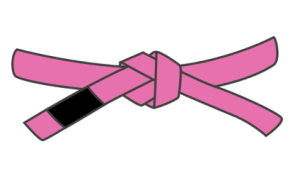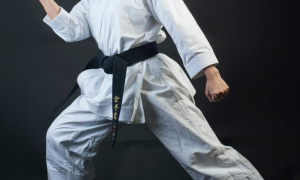
The short answer is yes, there is a pink karate belt, but it is not universally recognized across all karate styles and organizations. The use and meaning of a pink belt varies.
Table of Contents
Toggle![]()
Origins of the Karate Pink Belt
The pink belt was originally introduced in some schools as a belt rank between the white and yellow belts. It provided an intermediate step for students as they progressed through the lower ranks.
Some key points on the pink belt:
- Originally intended as a motivating factor for newer students, especially kids
- First appeared in some Shotokan schools in the 1970s-1980s
- Also adopted by some Taekwondo schools
- Not recognized by major karate organizations
So while the pink belt has been used informally, it is not an official rank according to most major karate associations. It’s important to note that unusual and unorthodox belt colors like pink can be a red flag for lower quality schools, so students should tread carefully. While the motivational intent behind a pink belt may be valid, relying too heavily on non-traditional ranks can indicate that the curriculum and standards are not up to par. When evaluating a new school, prospective students should scrutinize things like the belt system and the reasoning behind any unusual belts. Quality schools will focus more on perfecting the traditional color ranks rather than inventing new ones.
![]()
Uses of the Pink Karate Belt Today
Here are some of the ways the pink belt is used in karate today:
- Motivational tool – Some schools award a pink belt to white belts who are progressing well. This provides encouragement in the early stages.
- Women’s belt – A few schools use a pink belt specifically for female students instead of the traditional white belt. This represents a nod to the growing number of women in karate.
- Special recognition – Pink belts may be given to students for special achievements like earning a high score on an exam or winning a tournament.
- Transition rank – Some schools continue to use it as an intermediate rank between white and yellow belts.
- Breast Cancer Awareness – Many martial artists wear pink belts to show support for breast cancer causes and spread awareness.
So the pink belt serves various roles based on the school, but it is still not considered an official karate rank by major organizations.
![]()
Official Stance of Major Organizations
The major karate associations do not recognize the pink belt as an official ranking. This includes organizations like:
- World Karate Federation (WKF)
- USA Karate
- World Union of Karate-Do Federations (WUKF)
- International Karate Association (IKA)
According to these bodies, accepted Karate belt rankings are white, yellow, orange, green, blue, purple, red, brown, and black. While individual schools can introduce their own belt colors, the pink belt currently has no formal standing.
![]()
Pros and Cons of the Pink Belt
Some potential benefits and drawbacks of using a pink karate belt within the system:
| Pros | Cons |
|---|---|
| Extra motivation for newer students | Can cause confusion about rankings |
| Highlights women’s involvement | Adds an extra testing/promotion requirement |
| Allows flexibility for schools | Dilutes the tradition of standard belt colors |
While unusual belt colors may raise questions in some cases, there are legitimate reasons that a dojo could implement a pink belt system. For instance, many martial artists proudly wear pink belts in support of Breast Cancer Awareness. The pink belt can symbolize strength and solidarity against this disease. Additionally, projects like the Pink Belt Mission founded by Aparna Rajawat promote women’s empowerment through martial arts training. So context matters when evaluating an unconventional belt ranking system. If the motivations align with positive causes like health awareness or women’s advancement, a pink belt can represent honorable intentions. As with any dojo, prospective students should investigate the full context before making conclusions about quality and legitimacy.
![]()
Is the Pink Belt Right for Your Dojo?
Should your school implement pink belts? Here are some factors to consider:
- How would it fit with your style and curriculum?
- Would students embrace it as a motivator?
- Could it alienate traditionalists?
- Would you use it for all students or just women?
- Are you willing to go against official standards?
Carefully weigh the pros and cons when deciding if pink belts could benefit your dojo. While not universally accepted, they can be used creatively to motivate certain groups of students.
![]() Image Source: Original raster imageBuddy23LeeDerivative vector imageJdcollins13GJJ alterationWikisian, CC BY-SA 3.0, via Wikimedia Commons
Image Source: Original raster imageBuddy23LeeDerivative vector imageJdcollins13GJJ alterationWikisian, CC BY-SA 3.0, via Wikimedia Commons


